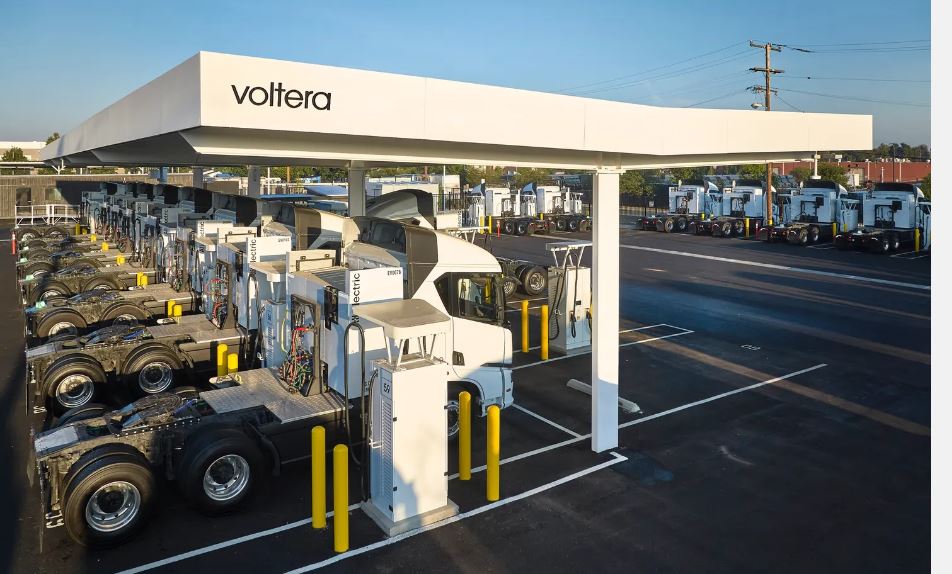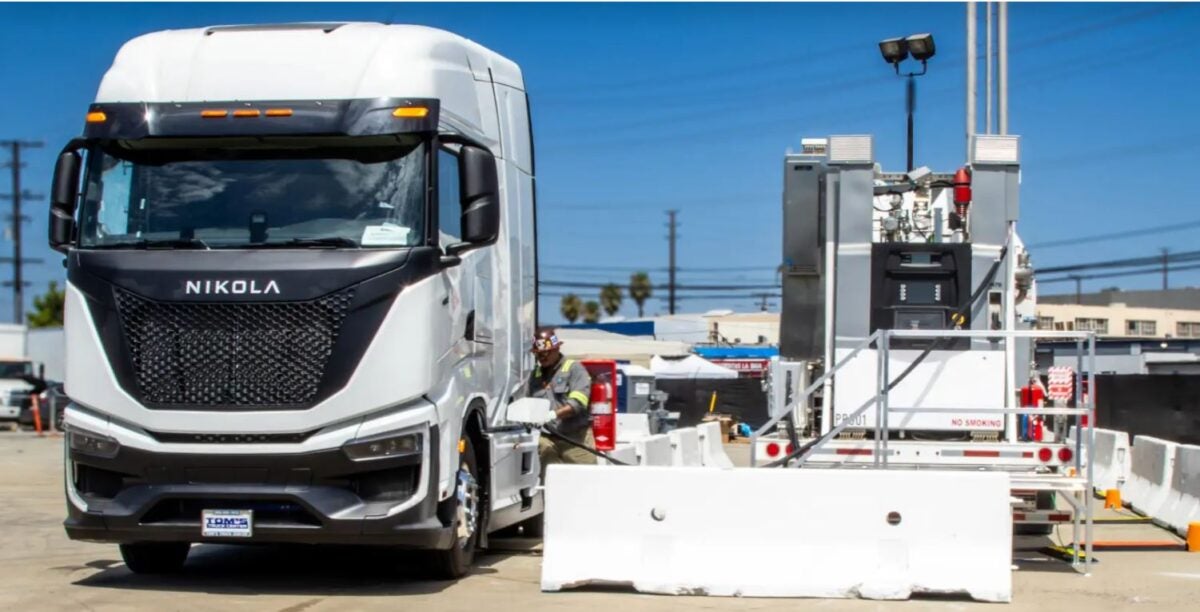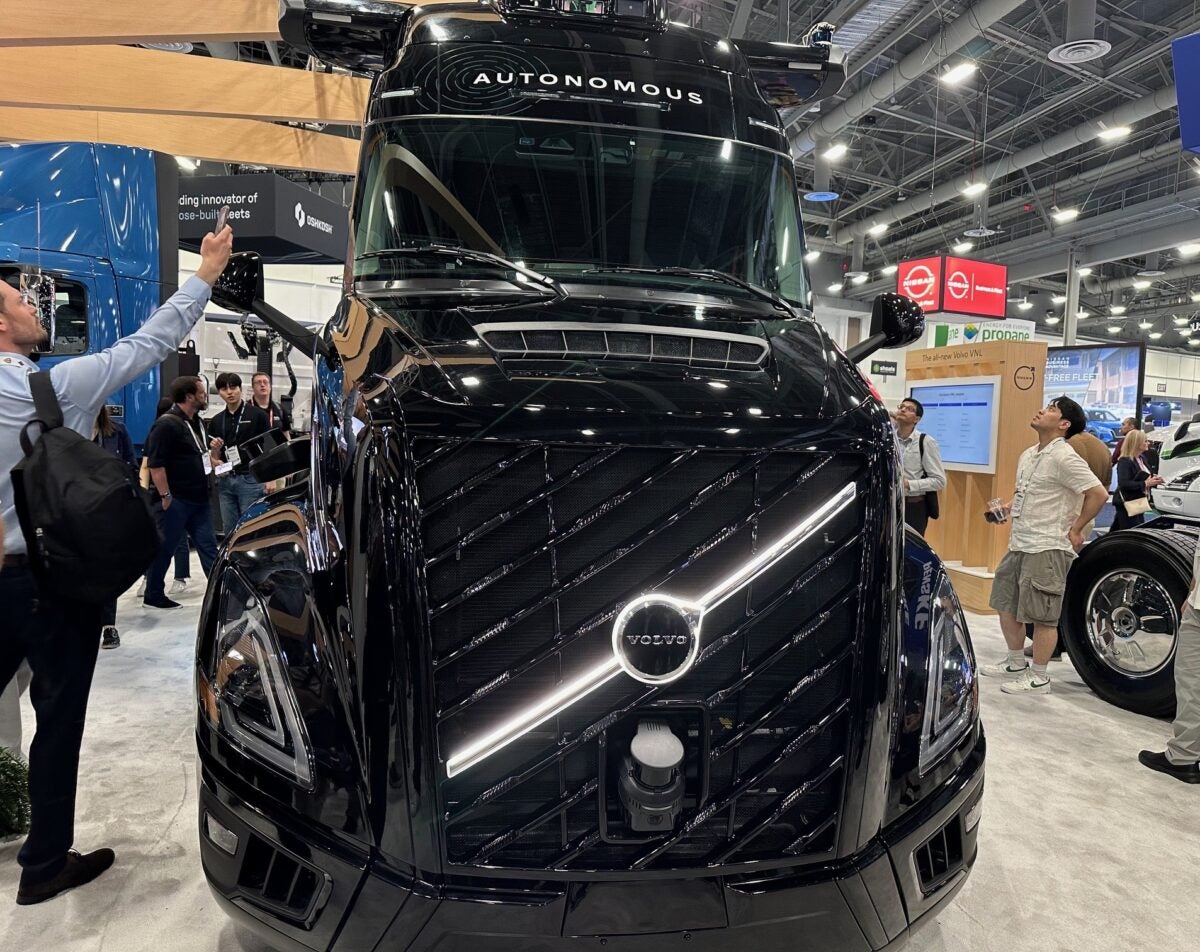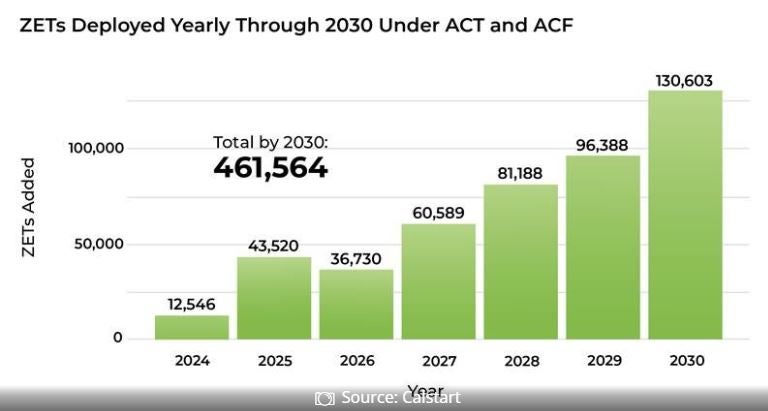A sign that startups are moving beyond their sometimes anxious early days comes when banks lend them money. It is starting to happen among certain nascent transportation and infrastructure developers.
When debt isn’t a dirty word
Many financial planners counsel individual households to erase debt. It is sort of the opposite for businesses. Bank borrowing can suggest health rather than distress.
For electric infrastructure developer Voltera, a $100 million debt facility – call it a credit line for capital investment – from ING Americas and Investec is a new source to grow its portfolio of charging infrastructure for electric vehicles.
“As a business,we are always looking [for] the lowest cost of capital that we can so that our projects can be financed less expensively and we can have lower price points for our end customers,” Voltera CEO Matt Horton told me.

electric trucks. (Image: Voltera)
Using equity financing, either through directly issuing new shares or promising them through a convertible debt term, costs more than what banks typically charge for a loan secured by collateral that protects the lender.
Voltera is using long-term contracts signed with electric fleet customers who pay to charge at its commercial depots. The quality of its real estate holdings matters to lenders, too.
“For us it really is a big validation of where we are as a business and the maturity that infrastructure in the charging space is moving into,” Horton said. “We think this will follow the same path [of] wind and solar and others … to become a mainstream investment category.”
Only the beginning?
Transforming commercial transportation to zero tailpipe emissions with adequate charging infrastructure will cost tens if not hundreds of billions of dollars.
“This is the starting gun for a tremendous amount of investment that’s going to flow into this space,” Horton said. “There are trillions of dollars of infrastructure capital sitting on the sidelines waiting for EV charging to mature to be a mainstream, investible infrastructure category.”
Voltera came out of stealth mode in 2022 backed by Stockholm-based EQT, which manages $273 billion in assets. EQT is still doing equity financing with Voltera, Horton said. Grants and other subsidies provide additional money to plow into future charging sites.
Sweden-based freight mobility technology developer Einride tapped two of those veins, securing a $200 million debt facility along with $300 million in equity financing in December 2022.
Getting banks on board can be a turning point
Over recent decades, bank borrowing financed build-outs in telecommunications, data centers, and solar and wind farms.
“All these big industries that have had to scale significantly, a major turning point for them is [when] the strength of the businesses and the contracts and the counterparties get the debt markets and banks comfortable to lend capital based on the projects that are being deployed,” Horton said.

But it’s not universal. Only as companies show a meaningful path to success do they get the banks interested. Voltera partnered with fuel cell truck maker Nikola to finance up to $1 billion to develop hydrogen fueling stations on up to 50 of its sites. Nikola lacks the financial strength to build out its planned hydrogen distribution on its own.
Debt facilities usually cheaper than equity financing
“Companies generally prefer to raise capital with debt offerings, which typically translate into a lower cost of capital,” Nikola CFO Thomas Okray told me.
Nikola relies almost entirely on equity financing, selling new shares to raise capital. Over time, that has diluted the holdings of current shareholders. On Monday, Nikola pulled the trigger on another equity-based raise, issuing convertible debt for $160 million. It took half now – at 5% annual interest.
Nikola’s already depressed stock dropped 9.41% lower on Monday, contributing to a five-day decline of 14.84% through Thursday..
“Some new businesses that do not have established businesses have difficulty – due to credit-worthiness – getting debt financing at attractive rates,” Okray said in a statement not pertaining specifically to Nikola. “These companies raise capital with equity.”
Aurora sold the markets on less-tangible assets
Autonomous trucking developer Aurora Innovation raised more than $600 million in a private placement of stock with Wall Street investors in July 2023. That included $125 million purchased by T. Rowe Price Investment Management Inc. Aurora sold $220 million more in shares to the public at the same time. It recently sold $483 million in another public sale.
“It really depends on the company, its leadership, business model, TAM [total addressable market], technology leadership, etc.,” David Maday, Aurora CFO, told me. “In our case, it was those proof points instead of customer contracts.”

Maday is no fan of borrowing to finance debt.
“Debt financing should be a last resort for companies that do not have positive free cash flow unless the financing is long-tailed at very attractive rates, or if no other options exist,” he said.
Convertible debt mollifies investors who want some guaranteed return, Maday said. “But my general feeling is converts are just more expensive equity financing.”
A new asset class
Andrew Karetsky founded Skyview Ventures in 2008. He has watched clean-tech businesses evolve from equity to debt financing with tax credits for green projects as a third revenue source.
“It was mostly real estate guys,” Karetsky told me. “They’d build them with equity, which is not the most efficient use of your equity. And then they would [ask], ‘How can I put debt on it; how can I realize the value of the ongoing incentive[s]?’”
Skyview operates infrastructure developer Skycharger as one of its three businesses. It sees the same opportunity for electrification as other clean-tech predecessors. Skycharger is developing a charging site at the Port of San Diego. It also has a contract with Pepsi for charging delivery vans and trucks in Northern California.
“As things matured in the solar market, debt and tax equity became institutionalized. And it allowed a smaller amount of equity to leverage the number of projects that we were doing. I would anticipate the same thing’s going to evolve here. It’ll [allow] the equity piece to recycle to build [more sites] more quickly.”
The post-pandemic stress in traditional commercial real estate is also a factor.
“It’s a new asset class,” Karetsky said of electric infrastructure. “If you’re an institution that has a high concentration of debt in a certain area, you’re probably looking to expand into other areas. This is another area of expansion.”
Workhorse tries to hang on for electric trucks to catch on
Workhorse Group might not survive financially for the next 12 months. It missed second-quarter revenue projections and saw widening losses.
The Cincinnati-based electric step van and chassis maker has just $5.3 million in cash. Money due on the sale of vehicles was entangled in red tape surrounding buyer incentives.
“The first half of 2024 saw slower-than-anticipated industrywide electric vehicle adoption rates, driven by the lack of government policy enforcement and delays in funding incentives available to our California dealers,” Workhorse CEO Rick Dauch said on the company’s earnings call Tuesday.
Less than 2% of Class 4 to 6 new truck registrations – where Workhorse plays – have received California Hybrid and Zero-Emission Truck and Bus Voucher Incentive Project incentives over the past two years. That is well below the 9% targeted for the fleet operators in 2025.
“We’re optimistic that demand going into 2025 and beyond will begin to materialize and grow, driven by increasing federal and state emission requirements and mandates,” Dauch said.
Delayed mandates challenge Workhorse’s survival
Those mandates include enforcement of California’s Advanced Clean Trucks (ACT) and Advanced Clean Fleets (ACF) rules. Three legal actions challenge the implementation of those rules that effectively make a market for zero-tailpipe-emission vehicles in the Golden State.
Enforcement cannot come soon enough for Workhorse, which has laid off half its workforce and sold its drone business to conserve cash. The company has $112.7 million of $139 million left to tap from a securities purchase agreement reached in March.
But Workhorse’s flagging share price – despite a 1:20 reverse stock split in June – fell below the Nasdaq listing requirement of $1 following Tuesday’s earnings report and traded 19.26% lower over the past five days through Wednesday. That could reduce how much money it can access from future stock purchases.

Calstart forecasts that approval of the ACT rule by additional states and California’s implementation of the ACF rule will lead to significant sales growth of electric trucks.
“Being a pioneer in the commercial EV space is hard work, and we need both industry and government leaders to live up to their public commitments on addressing GHG [greenhouse gas] emissions,” Dauch said. “To generate revenue and establish a viable business here at Workhorse, we need customers to buy trucks.”
Briefly noted …
Volvo Trucks’ biggest customer, DSV, has signed on for 300 heavy-duty electric trucks in Europe, among the largest single orders to date.
Middle-mile autonomous truck developer Gatik continues to look east for investment, adding Japan-based Nippon Express Holdings as a strategic investor.
Hong Kong-based Jardine Engineering Corp. is the latest to sign a non-binding deal with Hyliion Holdings to explore use of Hyliion’s Karno fuel-agnostic generator technology.
Truck Tech Episode No. 79: Safety technology embedded in new Volvo VNL platform
Have you used your discount offer for the Future of Freight Festival in Chattanooga, Tennessee, this November? It’s time. Meanwhile, time is short to submit nominations for the FreightTech 25. Nominations close at 6 p.m. EDT on Sept. 6. Winners will be announced at F3.
That’s it for this week. Thanks for reading and watching. Click here to subscribe and get Truck Tech delivered to your email on Fridays. And catch the latest episodes of the Truck Tech podcast and video shorts on the FreightWaves YouTube channel.Send your feedback on Truck Tech to Alan Adler at aadler@firecrown.com.







